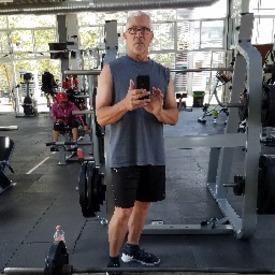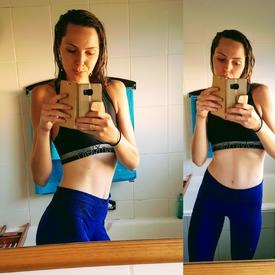High reps vs low reps
Replies
-
I am 67 and have been running PHUL for a few months now. It goes the spectrum with rep ranges with 2 power days and 2 hypertrophy days.
The recommendation on the power days is to not go to failure. That and good form will minimize injury risks. I've seen great results from this program!4 -
I'm a big believer in heavy weights if done correctly. With a small investment in a power rack you can do heavy weights safely in your garage. I recommend "Starting Strength" by Rippetoe. If you aren't progressively adding weight to the bar then you are missing out on some benefits (like increased strength.) If you get plugged into Starting Strength (it has a forum too) there are lots of older guys lifting heavy weights, safely (some lifting incredible amounts). The risk of injury is always there for anything... I know a jogger personally who dropped dead while out running. Some tweaked muscles probably aren't going to kill you! Best wishes.1
-
Keto_Vampire wrote: »@psuLemon for the great visual aid
Not much to add, but if you are training for hypertrophy, you might want to include both low & high rep range sets in your regimen. Many ways you can rotate things if hitting each body part 2X/week...ex) squat for reps (12-15) on leg day 1, 2nd leg day, squat for strength (6 reps/set).
I'm not too crazy about strength lifts myself(like you due to injury risk) but I still do 2-3 strength exercises per session (6-9 sets) and about 2/3rds sets in the moderate (8-12) to high (15+) rep range
Not to attack you but...but injury risk is pretty much non existent if using proper form with good programming. Example powerlifting is statistically one of the safest sports a person can do and alot of the programming is based on strength.
I don't think that "pretty much non existent" tells the whole story here though. Depending on what study you are looking at, competitive bodybuilding injury rates are around 0.2-1/1000 hours while competitive powerlifting rates are around 1-4/1000 hours, and injury rates for subelite powerlifters are at the high end of the spectrum
https://www.reddit.com/r/bodybuilding/comments/39ef2z/til_the_injury_rate_for_competitive_bodybuilding/
https://www.ncbi.nlm.nih.gov/pmc/articles/PMC5954586/
Both are relatively low compared to many other sports, but typical bodybuilding injuries are also much less traumatic than typical powerlifting injuries. I blew my hammy with a grade 2 strain this year, blew a pec with a grade 2 a few years ago, and herniated a disc in my lumbar a few years ago as well. Those all happened during heavy lifts, in the middle of planned 5-rep sets. Not at the end of the set where form might be getting a little sloppy. You don't usually hear about that level of injury happening while using lighter weights. I don't have the statistics to support that, so you can dismiss my n=1 if you want but tendons, joints, and recovery capabilities do diminish with age and there is so much more that can go wrong when you are lifting 500 lbs compared to when you are lifting 250 lbs
But back to the OP, he said he wants to get away from heavy lifts because he doesn't have a spotter so this is really a moot point. I agree that at least a little bit of heavy lifting is optimal even if he does not care about strength at all, but it is not necessary to make good hypertrophy progress.
Do we know what the programming and form was like is the question since that what my statement was based on? I said it was safe compared to other sports, not that they won't happen.
Perhaps you had off form or sub par programming at the time. Sometimes people just unravel for many reasons and I would hazard most injuries have less to do with the amount of weight on the bar, and more to do with how they managed the weight since the number is relative to one's strength. People taking enhancements isnt exactly friendly to the tendons/joints as ypu will find quite frequently with bodybuilders and powerlifting.
As far as age is concerned, strength training has more benefits and out weigh any excuse not to. Its proven that it extends the quality of life for those of advanced age. Lifting heavy at a useful intensity with good form should not be a red flag.
Also I have a some knowledge of tendons and joints with recovery since I have a autoimmune disease that is the cause of rapid deterioration of both and causes much pain and swelling 24/7 at age 49.
Yet, since lifting on the heavy side of strength training with proper programming and form, I'm no longer walking with a cane or I haven't been in a in a wheel chair for 7 years other than operations. I lifted sucessfully all these years with a herniated disc with no problems for recovery. Somehow I managed to break many state records in powerlifting and considered stronger than the majority of my age all without one major injury during training or meets many of those years while playing other sports competitively as well.
Mind you this is me, one person...not much data here from this example. But if you feel your experience is valid, mine would be just as much, no?
Have a good day .
.
Perhaps we are both statistical outliers regarding injuries then. Congrats on finding a way to keep your disease at bay. Cheers.1 -
Look up periodized programs they mix both0
-
I run through something called Russian pyramid training, this takes advantage of this scale. You start with 50% at 3x15 and work up to you max. Recalculate numbers and then work down the scale back to 50%. You keep doing this cycle and slowly your max should go up. You work strength and endurance muscles in the whole cycle chaining physical strength and endurance which rounds out all the muscle movements you need.0
Categories
- All Categories
- 1.4M Health, Wellness and Goals
- 391.3K Introduce Yourself
- 43.5K Getting Started
- 259.7K Health and Weight Loss
- 175.6K Food and Nutrition
- 47.3K Recipes
- 232.3K Fitness and Exercise
- 388 Sleep, Mindfulness and Overall Wellness
- 6.4K Goal: Maintaining Weight
- 8.5K Goal: Gaining Weight and Body Building
- 152.7K Motivation and Support
- 7.8K Challenges
- 1.3K Debate Club
- 96.4K Chit-Chat
- 2.5K Fun and Games
- 3.2K MyFitnessPal Information
- 22 News and Announcements
- 907 Feature Suggestions and Ideas
- 2.2K MyFitnessPal Tech Support Questions




